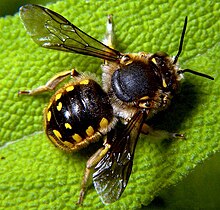| Anthidium manicatum | |
|---|---|

| |
| Scientific classification | |
| Domain: | Eukaryota |
| Kingdom: | Animalia |
| Phylum: | Arthropoda |
| Class: | Insecta |
| Order: | Hymenoptera |
| Family: | Megachilidae |
| Genus: | Anthidium |
| Species: | A. manicatum
|
| Binomial name | |
| Anthidium manicatum | |
| Synonyms | |
|
See text
| |
Anthidium manicatum, commonly called the European wool carder bee,[1] is a species of bee in the family Megachilidae, the leaf-cutter bees or mason bees.[2]
They get the name "carder" from their behaviour of scraping hair from leaves[3] such as lamb's ears (Stachys byzantina). They carry this hair bundled beneath their bodies to be used as a nest lining.[4] Like other members of the tribe Anthidiini, these bees do not cut leaves or petals as is typical for megachilids.[5] The males engage in territorial behaviour, aggressively chasing other males and pollinators from their territory.[6]
This bee is native to Europe, Asia, and North Africa. It has recently been seen in regions of South America, New Zealand, and the Canary Islands. They are generalists, and do not seem to prefer any plant genera for foraging, although in New Zealand, native plants are visited less frequently by this bee species.[7]
It was accidentally introduced into North America from Europe some time in the mid-20th century, first seen in 1963 near Ithaca, New York, and since then an invasive pest.[6]
- ^ Species Anthidium manicatum – European Wool Carder Bee – BugGuide.Net
- ^ Wool Carder Bee / Leafcutting Bee – Anthidium manicatum
- ^ Anthidium manicatum – Wool Carder Bee Archived July 28, 2010, at the Wayback Machine, Bees, Wasps & Ants Recording Society
- ^ Wool Carder Bees – Anthidium manicatum – UK Safari
- ^ Michener, C.D. (2000). The Bees of the World. Johns Hopkins University Press. 913 pp.
- ^ a b Graham, Kelsey K. (6 May 2015). "Bee battles: why our native pollinators are losing the war". The Conversation. Retrieved 10 July 2020.
The European wool-carder bee was first discovered in North America in 1963 near Ithaca, New York, and since then, its impact has been felt from coast to coast.
- ^ Soper, J.; Beggs, J. R. (December 12, 2012). "Assessing the impact of an introduced bee, Anthidium manicatum, on pollinator communities in New Zealand". New Zealand Journal of Botany. 51 (3): 213–228. doi:10.1080/0028825X.2013.793202.